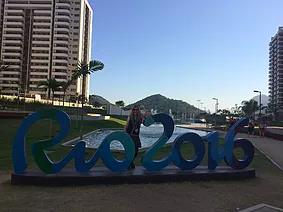September 19, 2016 :“Rebuilding cities after years of conflict includes building adequate sport spaces.” – Dana Podmolikova
Sports related headlines have plastered almost every front page this summer, from the International Day of Sport for Development and Peace to the 2016 Rio Olympics to last night’s closing ceremony for the Paralympics. Naturally, PVBLIC jumped in on the bandwagon.
To join the celebrations, I had the honor of speaking with Dana Podmolikova, the Youth and Urban Sports Specialist at UN-Habitat (United Nations Human Settlements Programme), who was kind enough to Skype me despite her jetlag from returning from Rio, where she helped amplify #SportOnRoadto2030, a hashtag working in tandem with the 2030 global agenda, as an advocate for youth involvement in civic participation.
An initiative jump started by the United Nations, the 2030 global agenda outlines 17 Sustainable Development Goals (SDGs) for a more peaceful world by 2030, and sport is an often overlooked tool for achieving each objective. Essentially, sport is a microcosm where people from all different backgrounds and upbringings come together for one common love that serves as a platform for ingraining valuable life skills, increasing well-being and economic participation (in line with SDG 1: ending poverty), supporting nutritional and food sustainability education (SDG 2: ending hunger), and communicating positive behavior and lifestyle choices (SDG 3: ensuring healthy lives). Cities investing in public sport programmes and play areas not only benefit from the indirect perks of sport as a tool of empowerment but also as a direct tool for lowering the risk of young people involved in risky or dangerous behavior and strengthening communities ties (SDG 16: promoting peaceful and inclusive societies).
“Sport is the connector between conflicting groups. Let’s use it for peace building and reconstruction.”
– @DanaPodmolikova
During a high-level event hosted by UN-HABITAT and Nexus Brasil, Dana discussed SDG 16 and how to use sport as a tool for peace building, conflict resolution, and countering violence with several trail-blazers in community sport development. One such leader included Mr. Duran Farah, Head of Somali NOC, who spoke about how sport functions as a universal bridge between conflicting groups in countries like Somalia, which has been at war for 25 years and where illiteracy rates are as high as 62%.
“We don’t have enough spaces for young people to play. Especially for young women that need adequate and safe space it is a challenge. Sport is the only thing that remained, the only institution that has not failed, yet there is no money and no support to develop more spaces for young people to practice. We need to work with international partners to rebuild our cities that will provide for everybody, especially for our youth that makes up 75% of our population. That includes building a sufficient sports infrastructure,” Farah says.
This sports infrastructure is a guiding principle in attaining the 2030 global agenda’s Sustainable Development Goal 11: making cities inclusive, safe, resilient, and sustainable. Dana’s role in achieving this SDG includes parlaying sport public space development into stronger community ties. She focuses on making cities more livable through three different angles in the youth & sport sector: 1) sport in relation to public space, sports infrastructure, and sports possibilities in public spaces, open outdoors or youth centers; 2) sport for peace building and conflict resolution; and 3) sport as a tool to address urban challenges.
“There is a huge importance in developing [sports infrastructures and public spaces for youth], economically and socially. Economically, it’s going to boost up the city’s attractiveness, sparking more opportunities for business that would otherwise be conflicted in committing to invest. Socially, it empowers young people, develops them [into leaders]. It’s a cycle really,” says Dana. “But every city is unique and deserves a unique approach.”

According to Dana, youth empowerment should come from the young people themselves, for they are the ones creating their community’s personality and sociopolitical dynamics. The answer to youth empowerment and driving social change lies not only in education, but in action. She states, “Young people are often unaware of the role they can play in creating change because they feel like they don’t know enough about the issues.” Dana is helping change this dynamic – she facilitates sports and urbanization workshops and is currently developing the concept of and writing funding proposals for the Urban Sport Programme for UN-Habitat. She also advises UN-Habitat on youth policies and participation based on the ideas and concepts that young people themselves have prioritized.
For Dana, sport is the easiest platform for meeting and engaging young people. “Of course there are other tools and platforms – not everybody loves sports and we have to recognize that; but there is something about sport that makes it unique and more attractive.” The way to improve young people’s access to information, communication, technology, and informal education is by providing them the necessary facilities and equipment. Hence, youth are given the opportunity to propound their ideas and develop as more inclusive, representative, and peaceful future leaders.
Article written by Kelsea Suarez for PVBLIC Foundation.
Published on PVBLIC Foundation website on 19th August, 2016 (www.pvblic.org)



